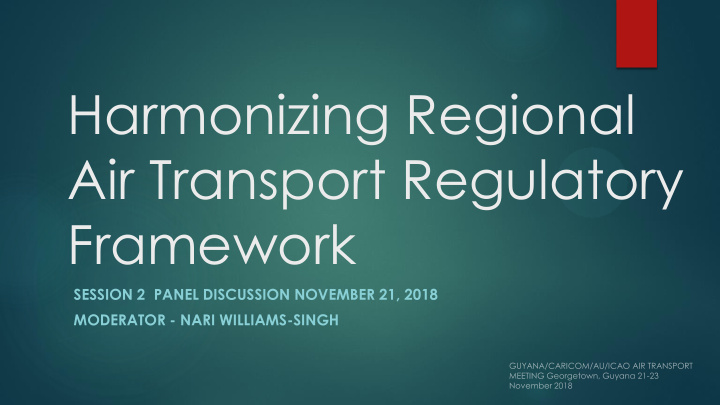



Harmonizing Regional Air Transport Regulatory Framework SESSION 2 PANEL DISCUSSION NOVEMBER 21, 2018 MODERATOR - NARI WILLIAMS-SINGH
Development of Air Transport in North America, Central America, The Caribbean and South America AIM OF DISCUSSION : Review the implementation status of the ICAO Statement on the Development of Air Transport Examine the Common Tools used in the region Policy Guidance Best Practices for harmonization Compatibility of these Regulatory Regimes in your Region
Harmonization of Regulatory Regimes Despite the challenges associated with the harmonization of regulatory regimes and policies which prevent stakeholders reaping all the benefits that aviation can provide because regulations remain nationally based in certain areas including training. However, the number of liberalization agreements signed between ICAO Member states over the past 10 years clearly demonstrates consensus on the benefits to be gained. Although differences remain in the areas of consumer protection, competition and taxation Consumer Protection The protection and improvement of airline passenger rights has gained greater importance. There is an urgent need for consumer education and for airlines and regulators to work together to formulate policies and rules States regulate using – general consumer protection rules specially developed regulation Industry Many airlines use voluntary commitments to improve their policies and practices including refunds, flight delays and cancellations etc .
Competition Increased competition comes through air services Agreements that: couples market access with other open-skies elements, including provisions that eliminate government interference in airlines’ commercial decisions on capacity and pricing; establishes pro-competitive elements on user charges, doing- business matters and cooperative arrangements; increases competition and provide broad economic benefits to both States and aviation stakeholders. Regional Liberalization provides a controlled and is one of the fastest ways to increase competition and enjoy the benefits of liberalization.
Competition cont’d Caribbean States recently concluded a revised Multilateral Air Services Agreement (MASA): Multiple designation of CARICOM carriers Traffic rights up to 7 th Freedom for passengers and cargo Cabotage The Latin American Civil Aviation Commission (LACAC) established a “Multilateral Open Skies Agreement in 2010. Plus several sub-regional initiatives were undertaken including: Decision 592 of the Andean Community of Nations (CAN) on Open skies Agreement of the Association of Caribbean States (ACS) on a more flexible air transport system; Fortaleza Agreement, which liberalizes traffic to regional locations
Taxation Taxation on air transport continues. There remains confusion between taxes and charges, surcharges and fees. The issue of high taxes, fees and charges, as they add to the cost of travel; the practices in some States in the region were not in line with the policies and guidance of ICAO on charges and taxation. It was pointed out that imposition of taxes such as Air Passenger Duty, Solidarity tax, VAT on sales of tickets, and jet fuel tax could have counterproductive effects that impede or slow down air transport development; Taxes and charges are high compared to basic fares, therefore lowering demand and revenues. There remains a strong call for States and relevant authorities to refrain from imposing such taxes and levies on civil aviation, and for ICAO to explore possible solutions, to strengthen the implementation of its policies on taxation.
Common Tools used in the Region Improved aviation infrastructure Non-discrimination Transparency Collaboration/partnerships
Policy measures Reduction in aviation charges Reduction in airport charges Better market access Greater Regulatory harmonization More efficient operations
BEST PRACTICES FOR HARMONIZATION The regulatory framework across the Region is not integrated. Different laws, regulations and regulatory practices add to airline costs. Harmonization of aviation laws, regulation and regulatory practice in the Region is essential to facilitate the seamlessness and efficiency of not only airport but also airline operations throughout the Region. Common laws and regulations will ensure certainty to encourage growth and cooperation initiatives among aviation industry stakeholders. However, harmonization is still possible and has been achieved to some extent but needs to be extended. Some best practices include: Costs savings Economies of Scale Uniformity, efficiency, seamless operations with the Region
COMPATIBILITY OF THESE REGULATORY REGIMES IN YOUR REGION The regulatory framework across the Region is not integrated. Different laws, regulations and regulatory practices add to airline costs. Compatibility of common laws and regulations will encourage growth and cooperation initiatives among aviation industry stakeholders.
THANK YOU Nari Williams-Singh, J.P. Director General, Jamaica Civil Aviation Authority 1 (876) 990 3469 (Mobile) 1 (876) 960 1758 (Direct)
Recommend
More recommend